Are you wondering what rules apply at a bouldering gym? Is it unclear to you which are the start and finish holds of a boulder problem?
In this article, you’ll learn everything you need to know about bouldering rules so that you can be comfortable, knowing you are doing everything correctly on your next visit to the bouldering gym!
Let’s get started.
⚠️ This article is tailored for bouldering gym use only. Different start and finish rules apply at bouldering competitions and this article should not be used for such.
📚 This post is part of our Bouldering Beginners Guide.
How to start and finish a boulder problem
You should start a boulder problem using the marked holds and no part of your body should be touching the floor or mat. To correctly finish the problem, you will need to match the final hold while maintaining a controlled position.
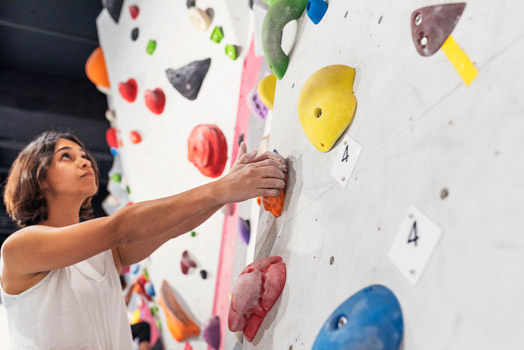
How to identify the start position
The starting hold of a boulder problem will always be marked either with tape, a sticker that reads ‘start’ or simply have the boulder grade attached to the starting hold. Each boulder problem has between one to four starting holds.
If only one starting hold exists, both hands have to match that hold. Typically, a match hold is indicated with two pieces of tape. Some gyms might add their own deviation. For example, they might add a sticker that says ‘2’ or a commercial gym might make it super obvious and add a helpful illustration.
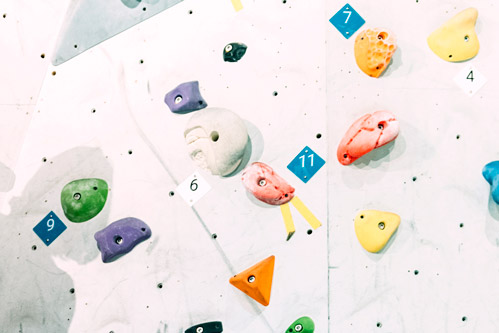
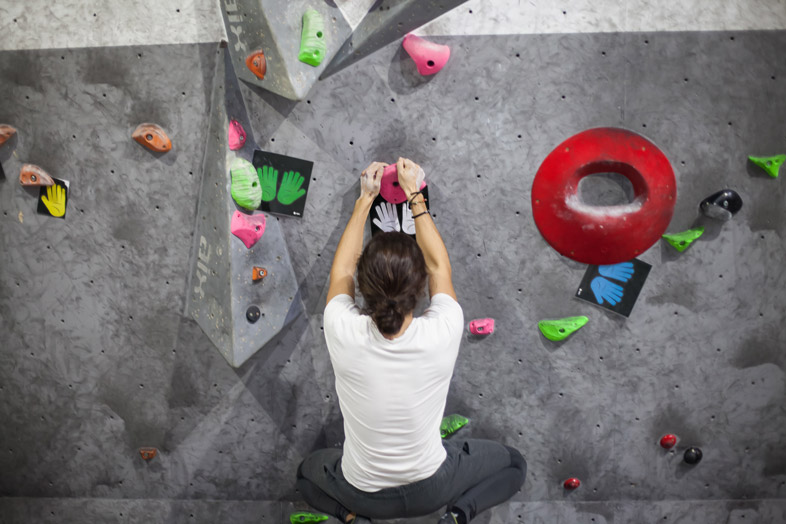
If a hold only has one piece of tape, this indicates that you grab that hold with a single hand. Some gyms mark both hand and foot holds. If this is the case, you have to use this exact starting position. However, most gyms only mark a single starting point. In this case, you can choose which foot holds you start with.
How to identify the end of a boulder problem
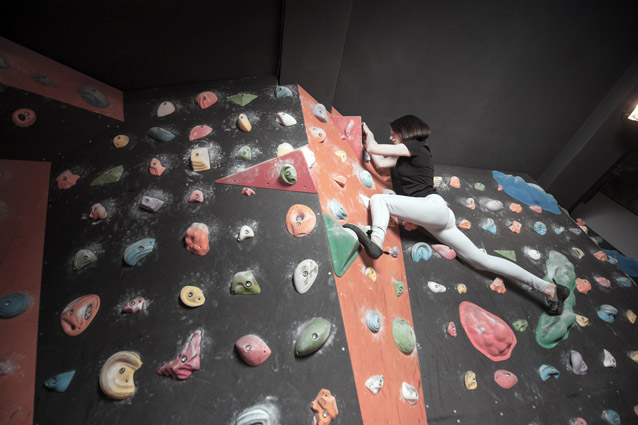
Most climbing gyms require the climber to finish the problem by touching the finishing hold with both hands (matching). This hold will likely be marked with a sticker that reads ‘TOP’ or a piece of tape.
When matching the finishing hold, the climber should be in a controlled state. Touching the hold while falling off is considered a fail.
At non-commercial climbing gyms, oftentimes, the finishing hold won’t be marked at all. In this case, you simply have to finish the problem by touching the highest hold of the boulder problem with both hands.
Some climbing gyms require the climber to top out by touching the top of the bouldering wall with both hands. If this is the case, the gym will likely have signs saying so.
A boulder problem is considered a fail if:
- The climber didn’t use the correct starting position
- Only one hand touches the final hold
- The climber falls off while matching the final hold
- The climber grabbed a wrong handhold or touched a wrong foothold during the attempt
- The climber touched the top of the wall during the attempt (unless the gym requires you to finish this way)
Which part of the wall you can use in between the start and finish holds?
While boulder problems are pretty straightforward, they can be confusing to newer climbers. One thing beginners struggle with is knowing which part of the wall is considered part of the route, and which part isn’t.
For instance, many beginner climbers tend to stick only to the hand and footholds in the color of the route. But sometimes, the route setter has incorporated other parts of the wall but hand and footholds.
After all, bouldering walls are known for their heavy usage of volumes. Volumes are the big geometric shapes that you will find on your bouldering wall, oftentimes they have holds placed on them as well.
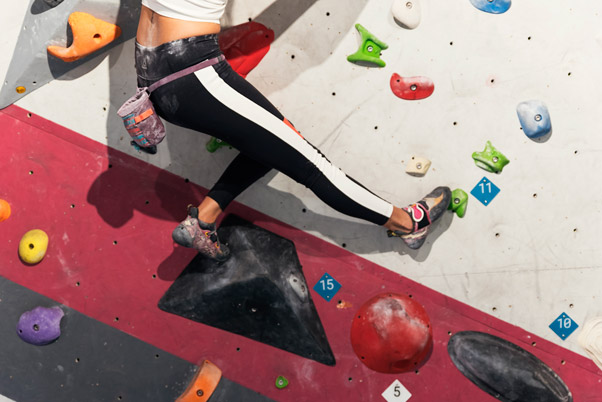
Did you know that you can use these volumes to send your boulder problem? You can smear off them, grab them and push/pull from and towards them. Volumes are your best friend at the bouldering wall and you should use them to your fullest extent. In most cases, if a volume is on your route, the setters have intended for you to use them to send your problem.
Besides volumes, other parts of the bouldering wall can be used as well. For example, you can smear on the wall itself, grab corners and touch the walls with your hands.
⚠️ Some climbing gyms have specific rules about what is considered ‘in’. In most cases, these rules will be displayed at the gym. If no such rules are on display, you can expect that you can use every part of the wall (except for the top). For more info, read: how much of a bouldering wall can you use?
Don’t be afraid to look silly
During your first couple of visits at the bouldering gym, you are bound to make a couple of mistakes. Don’t be anxious about this. You will likely start a problem wrong, touch a wrong hold or incorrectly finish your problem. These are almost unavoidable and as long as you are wearing rental shoes, the regulars aren’t going to make fun of you.
Worst comes to worst, an experienced boulderer will approach you and point out your mistake, in which case you might make a new friend.
You also shouldn’t be afraid to go a little rogue on the problem. If you are having trouble with a problem, it’s okay to cheat a little. Use a different starting point, touch a wrong color, it’s all good. This ain’t a competition, it’s a sport. And sports are meant to be fun.
Bouldering rules & Etiquette
Bouldering gyms have a lot of rules to make them as safe as possible. For your safety and others, it’s important that you make yourself aware of these rules and abide by them.
Here’s a list of rules that applies to most bouldering gyms.
- Don’t stand underneath when a climber is on the wall
- Don’t start a boulder problem if it will interfere with a climber who is already on the wall
- Look below you before jumping off a boulder problem, someone might be below you
- Look above you while walking around the boulder wall, someone might be above you
- Keep at least 4 feet distance from other climbers when bouldering to avoid collision
- Don’t hog the wall – check if other people are waiting before hopping on the wall
- Don’t consume drinks or foods on the mats (water is usually allowed)
- Don’t let your kids run around the mats
- Don’t go to the bathroom in your climbing shoes – bathroom floors are dirty, we don’t want those germs on the holds!
- Don’t climb in outdoor shoes – your outdoor shoes are dirty and will put germs all over the holds. Get rental shoes if you forgot your own.
- For safety reasons report any loose or spinning holds to staff
- Check with staff whether you can climb with a chalk bag on
- Check with staff whether you can climb shirtless

Bouldering etiquette:
- Don’t spray beta at other climbers
- Don’t blow chalk at other climbers
- Don’t use someone else’s chalk bag without permission (and please get your own ASAP)
- Don’t sit on the mats underneath boulder problems – you are forcing people to confront you
- If someone is brushing off holds, they are preparing to send that problem. Don’t beat them to it.
- Tape up if you start bleeding (and clean the hold)
- Keep your belongings away from the mats – a water bottle, brush or phone can cause someone to get seriously hurt if they fall on top of it
- Keep your grunts to a minimum – no one likes a climber that is disrupting the peace
Commonly used Bouldering Jargon
If you are reading this article as a preparation to go to a bouldering gym for the first time, it will be helpful to know some of the bouldering jargon as well. Here are some of the most commonly used terms in a bouldering gym.
- Send – Successfully finishing a boulder problem. Example usages: ‘nice send, dude’ to congratulate someone or: ‘I sent that blue one over there’ to refer to a particular route.
- Beta – Refers to the best approach to climb a boulder problem. You can help someone send a climb by giving them beta. Some problems have multiple betas for example a beta for short people and a beta for tall people. Example usage: ‘do you want the beta?’
- Spraying Beta – Refers to the act of giving unsolicited beta to another climber. Some climbers take pride in figuring out the beta themselves so you don’t want to ruin this for them by spraying beta. Example of spraying beta: yelling ‘You have to smear on the volume on your right’ at a stranger.
- An onsight – An onsight is when you successfully finish a boulder problem without any prior knowledge or beta. The term onsight is not that common in bouldering gyms though, most boulderers use ‘flash’ instead.
- A flash – A flash is when you successfully finish a boulder problem on your first try with the help of beta from another climber. Example: “I flashed that blue V3 over there”. Being able to flash problems is a great indication that you have mastered a certain bouldering grade range.
- Smearing – Smearing refers to placing your foot on the bouldering wall instead of a foothold. This can be used as a last resort when there is no proper foothold to push from.
Conclusion
Those are the rules that apply to bouldering gyms. As long as you follow them, you will be safe, keep others safe, and have a good time at your local wall.
If you are serious about bouldering, you should follow the correct start and finish rules. However, if this is your first time, don’t be afraid to go a little rogue and deviate away from them. Just make sure you have fun and are staying out of the way of others.
📚 Eager for more? Read our Bouldering Beginners Guide.
Continue reading
More articles like this
- Indoor Bouldering Basics: intro to gym climbing
- Tips for short climbers
- Complete Guide to Bouldering Grades (& conversions)
- How to start and finish a boulder problem
- Can I get abs from climbing?
- Bouldering vs rock climbing
- How often you should go bouldering per week
- Why bouldering is a good full-body workout
- Climbing 101: what is cutting feet?
- How long does it take to progress in bouldering?
- How much does it cost to start bouldering?
- What to wear indoor bouldering
- How much of a bouldering wall can you use?
- Should climbing shoes hurt?
- How many climbing shoes do you really need?
- Yoga for climbers
- Core workout for climbers